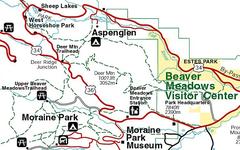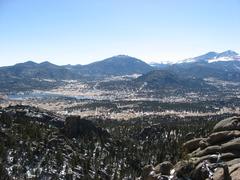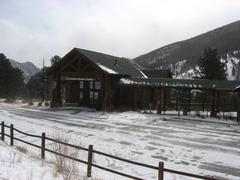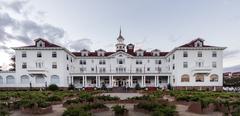
Moraine Park Discovery Center: Visiting Hours, Tickets, and Estes Park Historical Sites Guide
Date: 04/07/2025
Introduction
Located within Rocky Mountain National Park near Estes Park, Colorado, the Moraine Park Discovery Center and Amphitheater serve as vital gateways to the park’s breathtaking landscapes and rich cultural heritage. This historic site, rooted in both natural splendor and human history, offers visitors a blend of interactive exhibits, scenic trails, and engaging ranger-led programs. Built in 1923 as the Moraine Park Lodge by Imogene Green MacPherson and later transformed during the 1930s by the Civilian Conservation Corps (CCC) and the National Park Service (NPS), the center exemplifies “Parkitecture”—the National Park Service Rustic architectural style.
Operating seasonally from late spring through early fall, the Discovery Center provides free admission to visitors with a valid Rocky Mountain National Park pass. The center features exhibits on geology, glaciation, biodiversity, climate change, and the cultural narratives of Indigenous peoples and early settlers. Its adjacent amphitheater, a preserved CCC-era structure, regularly hosts ranger talks, community events, and even weddings, with accessibility accommodations for all visitors. Shuttle services from Estes Park and ample parking ensure easy access.
Strategically situated about 1.5 miles from the Beaver Meadows Entrance Station, the center serves as a starting point for several popular hikes and as a primary source for trail information, wildlife viewing tips, and conservation guidance. It also plays a key role in fostering community engagement and sustainable tourism in one of America’s most beloved national parks.
For up-to-date information, including current visiting hours, event calendars, and accessibility details, consult the NPS Moraine Park Discovery Center and Discover Estes Park. Digital tools like the Audiala app further enhance your visit with guided tours and real-time updates.
Table of Contents
- Introduction
- Visiting Information
- Historical Development and Significance
- Architectural Features and Preservation
- Cultural and Educational Role
- Best Times to Visit & Special Events
- Site Layout and Notable Features
- Exhibits and Educational Programs
- Visitor Experience & Practical Information
- Accessibility
- Nearby Attractions & Estes Park Historical Sites
- Frequently Asked Questions (FAQ)
- Summary and Travel Tips
- References
Visiting Information
- Location: Northeast corner of Moraine Park, 1.5 miles from Beaver Meadows Entrance Station, Estes Park, CO.
- Hours: Daily, 9:00 AM–5:00 PM, late May–mid-October (seasonal variations possible — check NPS Moraine Park Discovery Center page).
- Admission: Free with a valid Rocky Mountain National Park pass.
- Accessibility: Wheelchair-accessible trails and facilities, ranger support for visitors with disabilities.
- Parking & Transportation: On-site parking (fills quickly in peak season); shuttle services operate from Estes Park.
Historical Development and Significance
The Moraine Park Discovery Center originated as the Moraine Park Lodge in 1923, established by pioneering guide Imogene Green MacPherson. It functioned as a hub for early tourism in the region, set amid glaciated meadows and mountain vistas. The National Park Service acquired the property in 1931, marking a shift toward federal stewardship and public education. During the New Deal era, the CCC rehabilitated the building and constructed the adjacent amphitheater, furthering its mission as a center for interpretation and conservation. The site’s architectural and cultural significance was recognized with its addition to the National Register of Historic Places in 1976 (Wikipedia).
Architectural Features and Preservation
The Discovery Center and Amphitheater embody the National Park Service Rustic style, or “Parkitecture,” designed to harmonize with the natural environment using locally sourced stone and timber. Notable architectural features include:
- Materials: Native stone and timber for minimal environmental impact.
- Amphitheater: Natural bowl setting with plank seating, stone steps, and a fire circle, oriented for panoramic views of Moraine Park and Longs Peak.
- Preservation: Minimal alterations since the 1930s, maintaining historic integrity.
Cultural and Educational Role
The Discovery Center serves as a premier interpretive facility, with exhibits on:
- Geology & Glaciation: Interactive models and topographical maps illustrating the park’s glacial history.
- Biodiversity: Displays on wildlife, plant communities, and ecosystem interconnections.
- Human History: Artifacts and narratives honoring Indigenous peoples, early homesteaders, and conservation pioneers.
- Climate & Weather: Real-time weather data and educational panels on climate change impacts.
Ranger-led programs, Junior Ranger activities, and special events provide dynamic learning opportunities for visitors of all ages (NPS Education Programs).
Best Times to Visit & Special Events
Visitation peaks in late spring through early fall, when the center offers:
- Ranger-led guided hikes
- Wildlife and night sky programs
- Campfire talks at the amphitheater
Check the NPS events calendar for the latest schedules.
Site Layout and Notable Features
- Museum building: Interactive exhibits and a small bookstore.
- Amphitheater: Rustic seating, fire pit, and views of meadows and mountains.
- Trails: Stone steps and pathways connect the center to parking and nearby trailheads.
- Natural Features: Ponderosa pines, upland shrubs, and views of the Big Thompson River and Longs Peak.
Exhibits and Educational Programs
Geology & Glacial History
Explore the forces that shaped the Rockies through hands-on models and dioramas, making geological concepts accessible to all ages (Roadside Secrets).
Ecosystems & Biodiversity
Learn about the park’s diverse habitats, from montane meadows to alpine tundra, and the wildlife that calls them home. Rotating displays highlight seasonal changes and conservation challenges.
Human History & Cultural Heritage
Trace the stories of Indigenous peoples, early settlers, and the evolution of the park into a protected landscape. The building itself is a living artifact, retaining its rustic lodge character (Roadside Secrets).
Weather, Climate, & Environmental Change
Exhibits detail the park’s dynamic weather patterns and the effects of climate change, encouraging visitors to embrace stewardship principles.
Educational Programs
- Self-guided tours: Comprehensive interpretive materials for all visitors.
- Ranger talks and guided walks: Covering geology, wildlife, and park safety.
- Junior Ranger activities: Engaging young visitors in hands-on discovery (Reddit RMNP).
- Special events: Night sky programs, wildlife workshops, and more (NPS Education Programs).
Visitor Experience & Practical Information
- Hours: 9:00 AM–5:00 PM, late May through mid-October (verify before visiting).
- Admission: Free with park entrance pass; Bear Lake Road access may require a timed-entry reservation (Estes Park Blog).
- Parking: Limited; use shuttle during busy times.
- Amenities: Restrooms, bookstore, picnic areas. No food services—visit Estes Park for dining/lodging.
- Orientation: Rangers provide maps, safety tips, and trip planning support.
- Best times: Early morning and late afternoon for wildlife viewing; check weather conditions as they can change rapidly.
Accessibility
The center is designed to be inclusive for visitors of all abilities:
- Wheelchair access: Main exhibits and restrooms.
- Shuttle service: From Estes Park Visitor Center.
- Assistance: Staff available for special needs.
- Trails: Some uneven stone steps; inquire for current accessibility details (NPS.gov).
Nearby Attractions & Estes Park Historical Sites
- Bear Lake, Sprague Lake, and Glacier Gorge: Popular for hiking, wildlife, and scenic views.
- The Stanley Hotel: Historic landmark in Estes Park.
- Estes Park: Offers dining, shopping, and additional visitor centers.
- Amphitheater: Available for small events (reservations required; max 30 people).
Frequently Asked Questions (FAQ)
Q: What are the current visiting hours?
A: Open daily, 9:00 AM–5:00 PM, late May–mid-October. Always verify hours before your visit.
Q: Is there an admission fee?
A: Admission is free with a valid Rocky Mountain National Park pass.
Q: Are ranger-led programs available?
A: Yes, guided walks, talks, and Junior Ranger activities are offered seasonally.
Q: Is the Discovery Center accessible?
A: Yes, with accessible exhibits, restrooms, and parking.
Q: Can I bring my dog?
A: Dogs are allowed on leash in designated areas; not inside the Discovery Center.
Q: How do I get there without a car?
A: Use the Hiker Shuttle from Estes Park Visitor Center.
Q: How do I reserve the amphitheater?
A: Reserve through the NPS website.
Summary and Travel Tips
The Moraine Park Discovery Center and Amphitheater stand as enduring symbols of Rocky Mountain National Park’s dedication to conservation, education, and community. With origins as a private lodge and transformation under the CCC and NPS, the site now offers interactive exhibits, engaging programs, and easy access to the park’s most scenic trails. Plan ahead by checking the official NPS website for current hours and events, use shuttle services during busy periods, and take advantage of ranger-led programs. Enhance your experience with the Audiala app for guided tours, updates, and exclusive content.
Whether you’re a history buff, nature lover, or family seeking adventure, the Moraine Park Discovery Center is an essential stop in Rocky Mountain National Park.
Alt text: Moraine Park Discovery Center surrounded by ponderosa pines with Longs Peak visible in the distance.
Explore a virtual tour of the Moraine Park Discovery Center and Amphitheater
References
- Moraine Park Discovery Center and Amphitheater: A Historic Gem in Estes Park’s Rocky Mountain National Park, 2025, National Park Service (https://www.nps.gov/romo/planyourvisit/moraine-park-discovery-center.htm)
- Visiting the Moraine Park Discovery Center: Hours, Tickets, and Highlights at Rocky Mountain National Park, 2025, Discover Estes Park (http://discoverestesparkco.com/visitors-centers/)
- Exploring the Moraine Park Discovery Center: Visiting Hours, Tickets, and Estes Park Historical Sites, 2025, Roadside Secrets (https://www.roadsidesecrets.com/listing/moraine-park-discovery-center/)
- Moraine Park Discovery Center Visiting Hours, Tickets, and Visitor Guide in Rocky Mountain National Park, 2025, National Park Service (https://www.nps.gov/romo/planyourvisit/moraine-park-discovery-center-amphitheater-wedding-site.htm)
- Intermountain Histories (https://www.intermountainhistories.org/items/show/601)
- Inspired Imperfection (https://inspiredimperfection.com/adventures/moraine-park-discovery-center/)
- Wikipedia (https://en.wikipedia.org/wiki/Moraine_Park_Museum_and_Amphitheater)
- NPS Education Programs (https://www.nps.gov/romo/learn/education/selfguided.htm)
- Estes Park Blog (https://www.visitestespark.com/blog/post/you-booked-your-trip-to-estes-park-heres-a-guide-to-things-you-should-know/)
- Reddit RMNP (https://www.reddit.com/r/RMNP/comments/1dsd1l3/best_visitor_center/)
- Mountain Village Estes Park (https://mountainvillageestespark.com/estes-park-attractions/moraine-state-park/)
- The Tourist Checklist (https://thetouristchecklist.com/things-to-do-in-estes-park/)
- Exploding Travel (https://explodingtravel.com/places/moraine-park-discovery-center/)
- Evendo (https://evendo.com/locations/colorado/rocky-mountain-national-park/attraction/moraine-park-discovery-center)









